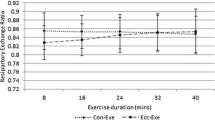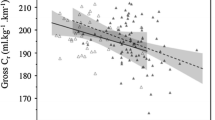Summary
Fifteen highly trained marathon runners gave their consent to participate in a study designed to investigate the effects of exercise-training on adipose tissue morphology and metabolism. They were submitted to an adipose tissue biopsy in the suprailiac region and their results were compared with an age and weight matched control group. As expected, runners were characterized by a lower percent body fat. They also had a significantly smaller mean fat cell diameter. Moreover, runners had significantly higher basal, epineprine sub-maximal, and epinephrine maximal stimulated lipolysis than controls. \(\dot VO_2\) max and body fatness were significantly correlated to adipocytes lipolysis. However, when seven runners were paired for mean fat cell diameter and percent body fat with seven sedentary control subjects, no differences in lipolytic activities were observed. These results indicate that high adipose tissue lipolytic activity is associated with low percent body fat in highly trained endurance runners.
Similar content being viewed by others
References
Allen TH, Peng MT, Chan KB, Huang TF, Chang C, Fang HS (1956) Prediction of total adiposity from skinfolds and the curvilinear relationship between external and internal adiposity. Metabolism 5: 346–353
Askew EW, Huston RL, Plopper CG, Hecker AL (1975) Adipose tissue cellularity and lipolysis: response to exercise and cortisol treatment. J Clin Invest 56: 521–529
Askew EW, Hecker AL (1976) Adipose tissue cell size and lipolysis in the rat: response to exercise intensity and food restriction. J Nutr 106: 1351–1360
Balke B, Ware RW (1959) An experimental study of physical fitness of Air Force personnel. US Armed Forces Med J 10: 675–688
Bukowiecki L, Lupien J, Follea N, Paradis A, Richard D, Leblanc J (1980) Mechanism of enhanced lipolysis in adipose tissue of exercise-trained rats. Am J Physiol 239: E422-E429
Carlson LA, Pernow B (1961) Studies on blood lipids during exercise II. The arterial plasma free fatty acid concentration during and after exercise and its regulation. J Lab Clin Med 58: 673–681
Clarkson PM, Katch FI, Kroll W, Lane R, Kamen G (1980) Regional adipose cellularity and reliability of adipose cell size determination. Am J Clin Nutr 33: 2245–2252
Costill DL, Dalsky GP, Fink WJ (1978) Effects of caffeine ingestion on metabolism and exercise performance. Med Sci Sports 10: 155–158
Dole VP (1956) A relation between non-esterified fatty acids in plasma and the metabolism of glucose. J Clin Invest 35: 150–154
Edwards DAW, Hammond WH, Healy MJR, Tanner JM, Whitehouse RJ (1955) Design and accuracy of calipers for measuring subcutaneous tissue thickness. Br J Nutr 9: 133–143
Friedberg SJ, Harlan WR, Trent DL, Estes EH (1960) The effect of exercise on the concentration and turnover of plasma nonesterified fatty acids. J Clin Invest 39: 215–220
Fröberg SO, Ostman I, Sjöstrand NO (1972) Effect of training on esterified fatty acids and carnitine in muscle and on lipolysis in adipose tissue in vitro. Acta Physiol Scand 86: 166–174
Hickson RC, Rennie MJ, Conlee RK, Winder WW, Holloszy JO (1977) Effects of increasing plasma free fatty acids on endurance. Fed Proc (Abstract) 36: 450
Howle SL (1978) Exercise and adipocyte metabolism in male and female rats. Med Sci Sports (Abstract) 10: 60
Issekutz B, Miller HI, Paul P, Rodahl K (1964) Source of fat oxidation in exercising dogs. Am J Physiol 207: 583–587
Ivy JL, Costill DL, Fink WJ, Lower RW (1979) Influence of caffeine and carbohydrate feedings on endurance performance. Med Sci Sports 11: 6–11
Leblanc J, Boulay M, Dulac S, Jobin M, Labrie A, Rousseau-Migneron S (1977) Metabolic and cardiovascular responses to norepinephrine in trained and non-trained human subjects. J Appl Physiol 43: 166–173
Lowry O, Passonneau J (1972) A flexible system of enzymatic analysis. Academic Press, New York
McGarr JA, Oscai LB, Borensztajn (1976) Effect of exercise on hormone-sensitive lipase activity in rat adipocytes. Am J Physiol 230: 385–388
Molé PA, Oscai LB, Holloszy JO (1971) Adaptation of muscle to exercise: Increase in level of palmityl CoA synthetase, carnitine palmityltransferase, and palmityl CoA dehydrogenase, and in the capacity to oxidize fatty acids. J Clin Invest 50: 2323–2330
Oscai LB (1979) Effect of acute exercise on tissue free fatty acids in untrained rats. Can J Physiol Pharmacol 57: 485–489
Owens JL, Fuller EO, Nutter DO, DiGirolamo M (1977) Influence of moderate exercise on adipocyte metabolism and hormonal responsiveness. J Appl Physiol 43: 425–430
Parizkova J, Stankova L (1964) Influence of physical activity on a treadmill on the metabolism of adipose tissue in rats. Br J Nutr 18: 325–332
Paul P, Issekutz B (1967) Role of extramuscular energy sources in the metabolism of the exercising dog. J Appl Physiol 22: 615–622
Paul P, Holmes WL (1975) Free fatty acid and glucose metabolism during increased energy expenditure and after training. Med Sci Sports 7: 176–184
Rennie MJ, Winder WW, Holloszy JO (1976) A sparing effect of increased plasma fatty acids on muscle and liver glycogen content in exercising rat. Biochem J 156: 647–655
Ritthaler F, Weiss M, Hack F, Weicker H (1980) Two biopsy techniques for human subcutaneous adipose tissue. Int J Sports Med 1: 50–51
Rodbell M (1964) Metabolism of isolated fat cells. J Biol Chem 239: 375–380
Siri WE (1956) The gross composition of the body. Adv Biol Med Phys 4: 239–280
Sutton JR (1978) Hormonal and metabolic responses to exercise in subjects of high and low work capacities. Med Sci Sports 10: 1–6
Thibault MC, Vallieres, J, Leblanc J (1981) Norepinephrine mobilization of free fatty acids in endurance trained rats. Eur J Appl Physiol 47: 313–322
Winer BJ (1971) Statistical principles in experimental design. McGraw-Hill, New York
Wilcox AR, Upton DE, Clarkson PM, Katch FI, Lane R (1981) Adipose cell size of distance runners before and after a 23 mile run. J Sports Med 21: 1–6
Author information
Authors and Affiliations
Additional information
Supported by FCAC-Quebec (EQ-1330, CE-29) and by Natural Sciences and Engineering Research Council of Canada (E-6227, G-0850, A-8150)
Rights and permissions
About this article
Cite this article
Després, J.P., Savard, R., Tremblay, A. et al. Adipocyte diameter and lipolytic activity in marathon runners: Relationship with body fatness. Europ. J. Appl. Physiol. 51, 223–230 (1983). https://doi.org/10.1007/BF00455185
Accepted:
Issue Date:
DOI: https://doi.org/10.1007/BF00455185




